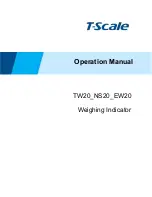
Liquiphant S, Nivotester
12
Hauser
Test procedure B
Procedure when it is not possible to approach the level but the device can be removed:
1.
Remove the Liquiphant electrically and mechanically.
2.
Connect the Liquiphant to the Nivotester electrically.
3.
Wait 10 seconds. (The tuning fork must be free).
4.
Check is the LED for permanent self-monitoring flashing (
– No: fault in the Liquiphant or Nivotester.
– Yes: make a note of the initial status of the fail-safe contact (open/closed).
5.
Check is the fail-safe contact closed?
– No: fault in the Liquiphant or Nivotester.
– Yes: dampen the tuning fork by immersing it in the medium.
6.
Make a note of the second status of the fail-safe contact (open/closed).
7.
Check is the fail-safe contact open?
– No: fault in the Liquiphant or Nivotester.
– Yes: remove damping: the tuning fork must be free.
8.
Install the Liquiphant and check electrical and mechanical installation.
9.
Make a note of the third status of the fail-safe contact (open/closed).
10. Check is the fail-safe contact closed?
– No: fault in the Liquiphant or Nivotester.
– Yes: the test is successful and normal operation is resumed.
!
Note!
With this type of test, the entire safety path from the tuning fork to the fail-safe contact is checked!
For troubleshooting,
→
Operating Instructions (
6, "Supplementary device documentation"),
Section "Troubleshooting".
If necessary, the accuracy of the switch point can also be checked,
→
Operating Instructions, Section
"Mounting the Liquiphant S".
Test procedure C
!
Note!
At the time of the test, ensure that the tuning fork is free!
Procedure when it is not possible to approach the level and the device cannot be removed:
1.
Make a note of the initial status of the fail-safe contact (open/closed).
2.
Check is the fail-safe contact closed?
– No: fault in the Liquiphant or Nivotester.
– Yes: press the "test" key (using tool) (
Do not
release!
3.
Check does the device respond to keypress?
– No: fault in the Nivotester.
– Yes: all LEDs lit (
13, "Flow diagram").
4.
Make a note of the second status of the fail-safe contact (open/closed).
5.
Check is the fail-safe contact open?
– No: fault in the Liquiphant or Nivotester.
– Yes: release the "test" key.
6.
Check does the test procedure run correctly (
– No: fault in the Liquiphant or Nivotester.
– Yes: make a note of the third status of the fail-safe contact (open/closed).
7.
Check is the fail-safe contact closed?
– No: fault in the Liquiphant or Nivotester.
– Yes: the test is successful and normal operation is resumed.
!
Note!
With this type of test, the entire safety path is not checked! The tuning fork is only included in test procedures
A or B.
For troubleshooting,
→
Operating Instructions (
6, "Supplementary device documentation"),
Section "Troubleshooting".
Содержание Liquiphant S FDL60
Страница 3: ...Liquiphant S Nivotester Endress Hauser 3 SIL Declaration of Conformity SIL 03013b ...
Страница 16: ...Liquiphant S Nivotester 16 Endress Hauser Technical report ManagementSummary ManagementSummary ...
Страница 17: ...Liquiphant S Nivotester Endress Hauser 17 ManagementSummary ManagementSummary ...
Страница 18: ...Liquiphant S Nivotester 18 Endress Hauser ManagementSummary ManagementSummary ...
Страница 19: ...Liquiphant S Nivotester Endress Hauser 19 ManagementSummary ManagementSummary ...
Страница 20: ...Liquiphant S Nivotester 20 Endress Hauser Certificate TUEV_Z10 03 11 20351 002 en ...
Страница 21: ...Liquiphant S Nivotester Endress Hauser 21 ...
Страница 22: ...Liquiphant S Nivotester 22 Endress Hauser ...
Страница 23: ...Liquiphant S Nivotester Endress Hauser 23 ...










































